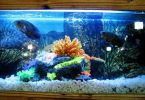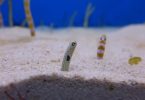Table of Contents
Pregnant or Bloated African Clawed Frog
Only animals such as mammals which give birth to live offspring become pregnant. African dwarf frogs lay eggs, which means they never actually get pregnant and do not give birth to live offspring. One way to tell if your African clawed frog is pregnant or bloated is too assess them.
If they start getting what looks like fat, especially if their belly is increasing in size, there’s a good chance the female is laying eggs.
Is my African clawed frog bloated?
Okay, so, if your frog looks like it’s getting too big and fat, you might be worried about bloat or a disease known as dropsy.
Here’s how to tell if your ADF is bloated VS pregnant;
Size and fat is one way to know if your frog is bloated, if your frog is round and the belly is smooth. Then your frog is bloated, not laying eggs.
Bloating disease
Common pain in African clawed and African dwarf clawed frogs as a result of large amount of fluids stored in a frog’s abdomen.
Symptoms
- The frog can live with this condition for a short time but soon it will make your frog lethargic and not eat which will cause a lot of pain and discomfort, and even death because like living things, the frog requires food to survive.
- Characterized by severe swelling of the limbs and body. Unless it is diagnosed and treated in the early stages, it is often fatal.
- Fluid begins to form under the skin. The frog’s body is unable to process the fluids which tends to accumulate under the skin and around the internal organs.
- Known to be related to genetic abnormalities or diseases of the kidney and liver.
Causes
From my research I have found that it is caused by an infection with a certain type of bacteria dropsy, which affects the lymphatic ducts that properly drain body fluids.. This fluid can be broken down naturally by the frog’s body if given proper conditions or medication.
Bacterial cases of the condition, which are often fatal, appear suddenly, while inflammation associated with dietary problems occurs gradually.
Frogs are so guilty of eating the things that they should have no business eating as it is not part of their diet, like rocks and gravels from an enclosure that can cause them to swell. In addition, it has been found to be higher in frogs that feed mainly on fatty foods such as bloodworms and beef heart. This is probably because the bacteria that cause inflammation may be present in the digestive tract or in the epidermis of the bloodworm.
Infections resulting from poor diet are not contagious, while bacterial infections can spread from one frog to another in the habitat. It is advisable to quarantine your frog during this situation.
Treatment
- Before you start treatment quarantine your frog, put it in a separate tank, 10 gallons is sufficient.
If the frog is the only resident of its own tank, it can stay there. If there is carbon in the filter, remove it before treatment. The filter is not needed for the treatment tank.
- Epsom salt and anti-internal bacterial tropical fish remedies have been shown to be successful. Note: Do not use table salt
- Begin a treatment regimen with Maracyn II or Maracyn Plus. Dosage as indicated on the package and monitor from there.
- Daily salt bath. Take an extra container – add about a gallon of dechlorinated water and 1/2 teaspoon of Epsom salt. Leave the frog here for an hour. Throw away the water and return the frog to its treatment tank.
- If there is no improvement even after 10-14 days, the case can be considered incurable. Continue to dip the salt for the rest of the frog and keep it separate and comfortable. Depending on the severity of the bloat, the frog’s lifespan is uncertain. Frogs can live for a few weeks, a few months, for the better part of a year. If it is caught early and the progression of bloat is halted, the frog may live a few years if lucky.
Other forms of treatment also include;
- Exotic vets are removing excessive fluid from your African dwarf frog’s abdomen. The frog will feel better because this reduces the pressure that rests on its limbs immediately. It is always advisable to see a vet in this case, attempting to drain the fluid without an expert can lead to complications because you might puncture what cannot be treated.
Preventative measures
- Does not spread from frog to frog – other healthy frogs require isolation in order not to stress them out by treating them for something they don’t have.
- Use spring water for frogs and not distilled water. Distilled water can cause electrolyte imbalance in African dwarf frogs which can cause bloating.
- Feed your African dwarf frog a high quality food.
- Do not clean with soap.
Treating the tank
If your frog is suffering from the bacterial form of the disease, you should try to reduce the number of bacteria in the tank as much as possible. Begin by completely emptying the tank and removing all substrate, plants, filters, and cage furniture.
Sterilize the tank with a 10 percent bleach solution and leave it full for 24 to 48 hours. Empty the tank and wash it thoroughly with clean, fresh water. Allow the tank to air dry for the next 24 hours, wash it one more time, and fill it with dechlorinated water.
Your Frog’s Ideal Habitat:
- Ideal water temperature should be around 75-80f.
- You should allow at least 2.5-3g of water per frog. An intake that is too strong can suck on the little flippers. A very strong current can equally stop them from getting to the top, so the ideal wave of current is between twelve and eighteen high, otherwise the frog will find it difficult to reach the air on top and then it becomes tired. Frogs are architects of escape so it is best to have a lid to avoid them sneaking away through little spaces. You can add river rocks that are smooth and small, also add silk plants or live plants and a cave that does not have sharp edges to beautify the aquarium and also provide the African dwarf frog with places to hide.
Recommended Diet for Your African Dwarf Frog
African dwarf frogs are meat eaters. Pellets for tadpoles and frogs are healthy options.
Feed them small meals once or twice in twenty-four hours. They can have a little bulgy stomach from this feeding routine. While there is no danger in not feeding the adult frog who can hunt for their food, it is important to attend to the young frogs.







